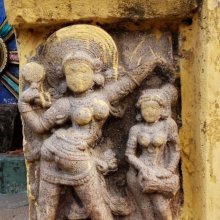Nivartana, Nivartanā: 15 definitions
Introduction:
Nivartana means something in Buddhism, Pali, Hinduism, Sanskrit, Jainism, Prakrit, the history of ancient India. If you want to know the exact meaning, history, etymology or English translation of this term then check out the descriptions on this page. Add your comment or reference to a book if you want to contribute to this summary article.
Images (photo gallery)
(+5 more images available)
In Hinduism
Purana and Itihasa (epic history)
Source: Cologne Digital Sanskrit Dictionaries: The Purana IndexNivartana (निवर्तन).—30 daṇḍas by a daṇḍa of 7 hastas.*
- * Matsya-purāṇa 283. 3, 14.

The Purana (पुराण, purāṇas) refers to Sanskrit literature preserving ancient India’s vast cultural history, including historical legends, religious ceremonies, various arts and sciences. The eighteen mahapuranas total over 400,000 shlokas (metrical couplets) and date to at least several centuries BCE.
Yoga (school of philosophy)
Source: ORA: Amanaska (king of all yogas): A Critical Edition and Annotated Translation by Jason BirchNivartana (निवर्तन) refers to “withdrawing (the mind)” (into Śakti), according to the Brahmayāmala-tantra (or Picumata), an early 6th century Śaiva text consisting of twelve-thousand verses.—Accordingly, while describing meditation (dhyāna) and samādhi: “[...] Therefore, [the Yogin] should perform meditation on the region in his heart, the navel, †[...]† [and] Bindu, [then] withdraw (nivartana) his mind into Śakti. In that way, an absorption [arises] in that no-mind, aspectless and highest state. He meditates in [that no-mind] state until impartiality [arises] in regard to the object of meditation. O goddess, when his [higher] faculty of discernment has become impartial to all the Tattvas, it is here called samādhi, distinguished by absorption in those [Tattvas]”.

Yoga is originally considered a branch of Hindu philosophy (astika), but both ancient and modern Yoga combine the physical, mental and spiritual. Yoga teaches various physical techniques also known as āsanas (postures), used for various purposes (eg., meditation, contemplation, relaxation).
Sports, Arts and Entertainment (wordly enjoyments)
Source: archive.org: Syainika Sastra of Rudradeva with English Translation (art)Nivartana (निवर्तन) refers to “dissuading someone” (from doing what is improper)”, according to the Śyainika-śāstra: a Sanskrit treatise dealing with the divisions and benefits of Hunting and Hawking, written by Rājā Rudradeva (or Candradeva) in possibly the 13th century.—Accordingly, [while discussing the importance of hawks]: “[...] To possess the knowledge of what is practicable and of the means to achieve it, to discern what is easily attainable and what is not, to employ proper persons for proper works and dissuade (nivartana) them from doing what is improper, and such other qualities, which have been highly spoken of in politics [are considered also essential in the art of hawking]”.

This section covers the skills and profiencies of the Kalas (“performing arts”) and Shastras (“sciences”) involving ancient Indian traditions of sports, games, arts, entertainment, love-making and other means of wordly enjoyments. Traditionally these topics were dealt with in Sanskrit treatises explaing the philosophy and the justification of enjoying the pleasures of the senses.
In Buddhism
Tibetan Buddhism (Vajrayana or tantric Buddhism)
Source: Wisdom Library: Tibetan BuddhismNivartana (निवर्तन) is the name of a Śrāvaka mentioned as attending the teachings in the 6th century Mañjuśrīmūlakalpa: one of the largest Kriyā Tantras devoted to Mañjuśrī (the Bodhisattva of wisdom) representing an encyclopedia of knowledge primarily concerned with ritualistic elements in Buddhism. The teachings in this text originate from Mañjuśrī and were taught to and by Buddha Śākyamuni in the presence of a large audience (including Nivartana).

Tibetan Buddhism includes schools such as Nyingma, Kadampa, Kagyu and Gelug. Their primary canon of literature is divided in two broad categories: The Kangyur, which consists of Buddha’s words, and the Tengyur, which includes commentaries from various sources. Esotericism and tantra techniques (vajrayāna) are collected indepently.
In Jainism
General definition (in Jainism)
Source: Wisdom Library: JainismNivartanā (निवर्तना) refers to “production” and it is one of the factors making up the 108 kinds of adhikaraṇa (‘substratum’) of the non-living beings (ajīva). This substratum (instruments of inflow) represents the foundation or the basis of an entity.
Nivartanā is a Sanskrit technical term defined in the Tattvārthasūtra (ancient authorative Jain scripture) from the 2nd century, which contains aphorisms dealing with philosophy and the nature of reality.
Source: Encyclopedia of Jainism: Tattvartha Sutra 6: Influx of karmasNivartanā (निवर्तना).—What is meant by production (nivartanā)? It means to create, to produce or to make. It is mainly of two types namely:
- of primary attributes,
- of secondary attributes.
Creating or making of body, speech, mind; beathing (inhalation and exhalation) are production of primary attributes. Creating or making of articles of wood, stone, clay or pictures etc. is called production of secondary attributes.

Jainism is an Indian religion of Dharma whose doctrine revolves around harmlessness (ahimsa) towards every living being. The two major branches (Digambara and Svetambara) of Jainism stimulate self-control (or, shramana, ‘self-reliance’) and spiritual development through a path of peace for the soul to progess to the ultimate goal.
India history and geography
Source: Cologne Digital Sanskrit Dictionaries: Indian Epigraphical GlossaryNivartana.—(IE 8-6; EI 21, 26, 28; CII 4), an area of land, which was not the same in different ages and localties. See Ind. Ep., pp. 409-10; also Matsya Purāṇa, 283. 14-15, represent- ing a gocarman as (2/3) of a nivartana (210×210 sq. cubits). (CITD), same as maṟuturu, the identification of the two being established by bilingual Sanskrit-Telugu inscriptions. Note: nivartana is defined in the “Indian epigraphical glossary” as it can be found on ancient inscriptions commonly written in Sanskrit, Prakrit or Dravidian languages.

The history of India traces the identification of countries, villages, towns and other regions of India, as well as mythology, zoology, royal dynasties, rulers, tribes, local festivities and traditions and regional languages. Ancient India enjoyed religious freedom and encourages the path of Dharma, a concept common to Buddhism, Hinduism, and Jainism.
Languages of India and abroad
Sanskrit dictionary
Source: DDSA: The practical Sanskrit-English dictionaryNivartana (निवर्तन).—a.
1) Causing to return.
2) Turning back, ceasing.
-nam 1 Returning, turning or coming back, return; इह हि पततां नास्त्यालम्बो न चापि निवर्तनम् (iha hi patatāṃ nāstyālambo na cāpi nivartanam) Śānti.3.2.
2) Not happening, ceasing.
3) Desisting or abstaining from (with abl.)
4) Desisting from work, inactivity (opp. pravartana); Kām.1.28.
5) Bringing back; Amaru. 84.
6) Repenting, a desire to improve.
7) A measure of land (2 rods).
8) Averting, keeping back from (with abl.) विनिपातनिवर्तनक्षमम् (vinipātanivartanakṣamam) Kirātārjunīya 2.13.
Source: Cologne Digital Sanskrit Dictionaries: Benfey Sanskrit-English DictionaryNivartana (निवर्तन).—i. e. ni-vṛt + ana, I. adj. Disappearing, Mahābhārata 6, 2427. Ii. n. 1. Return, [Rāmāyaṇa] 6, 92, 4. 2. Ceasing, Mahābhārata 1, 8388. 3. Abstaining from (abl.), 1, 373. 4. Inactivity, Kām. Nītis. 1, 28. 5. Bringing back, [Amaruśataka, (ed. Calcutt.)] 84. 6. Turning off from (abl.), [Vedāntasāra, (in my Chrestomathy.)] in
Nivartana (निवर्तन).—[adjective] the same; [neuter] return, cessation, desisting from ([ablative]); causing to return, bringing back from ([ablative]).
Source: Cologne Digital Sanskrit Dictionaries: Monier-Williams Sanskrit-English Dictionary1) Nivartana (निवर्तन):—[=ni-vartana] [from ni-vṛt] mfn. causing to turn back, [Ṛg-veda]
2) [v.s. ...] n. turning back, returning, turning the back id est. retreating, fleeing, [Atharva-veda; Mahābhārata] etc. (mṛtyuṃ kṛtvā nivartanam, making retreat equivalent to death id est. desisting from fighting only in death, [Mahābhārata vi, vii]; [wrong reading] kṛtvā mṛtyu-niv)
3) [v.s. ...] ceasing, not happening or occurring, being prevented, [Mahābhārata; Harivaṃśa] etc.
4) [v.s. ...] desisting or abstaining from ([ablative]), [Mahābhārata; Bhāgavata-purāṇa]
5) [v.s. ...] desisting from work, inactivity (opp. to pra-vartana), [Kāmandakīya-nītisāra]
6) [v.s. ...] causing to return, bringing back ([especially] the shooting off and bringing back of weapons), [Mahābhārata; Kāvya literature]
7) [v.s. ...] turning back (the hair), [Kātyāyana-śrauta-sūtra]
8) [v.s. ...] a means of returning, [Ṛg-veda; Atharva-veda]
9) [v.s. ...] averting or keeping back from ([ablative]), [Vedāntasāra]
10) [v.s. ...] reforming, repenting, [Horace H. Wilson]
11) [v.s. ...] a measure of land (20 rods or 200 cubits or 40,000 Hastas square), [Hemādri’s Caturvarga-cintāmaṇi]
Source: DDSA: Paia-sadda-mahannavo; a comprehensive Prakrit Hindi dictionary (S)Nivartana (निवर्तन) in the Sanskrit language is related to the Prakrit word: Ṇivaṭṭaṇa.
[Sanskrit to German]
Sanskrit, also spelled संस्कृतम् (saṃskṛtam), is an ancient language of India commonly seen as the grandmother of the Indo-European language family (even English!). Closely allied with Prakrit and Pali, Sanskrit is more exhaustive in both grammar and terms and has the most extensive collection of literature in the world, greatly surpassing its sister-languages Greek and Latin.
Kannada-English dictionary
Source: Alar: Kannada-English corpusNivartana (ನಿವರ್ತನ):—
1) [noun] the act or fact of accomplishing; accomplishment.
2) [noun] a coming back; return.
3) [noun] a being prevented (from happening).
4) [noun] disinclination for normal life rejecting material possessions, pleasures, etc.
5) [noun] a repenting or being penitent; feeling of sorrow, etc., esp. for wrongdoing; compunction; contrition; remorse; repentance.
6) [noun] the act or an instance of returning, paying back (something that was taken).
7) [noun] a sudden move in wrestling escaping from being caught; an evasive move.
8) [noun] a catching or holding.
9) [noun] a particular measure or area of land (approx. equal to five acres).
Kannada is a Dravidian language (as opposed to the Indo-European language family) mainly spoken in the southwestern region of India.
See also (Relevant definitions)
Starts with: Nivartanastupa.
Ends with: Anivartana, Avinivartana, Cetonivartana, Chandakanivartana, Chetonivartana, Chhandakanivartana, Kriyanivartana, Manivartana, Pratinivartana, Punahpratinivartana, Runnivartana, Samnivartana, Saprayoganivartana, Vinivartana.
Full-text (+35): Nivattana, Gocarman, Nivartanastupa, Samnivartana, Anivritta, Anivartin, Anivartana, Pratinivartana, Anivartitva, Nivarta, Chandakanivartana, Nardabuda, Saprayoganivartana, Runnivartana, Alamba, Samnivartita, Vinivartana, Withdrawing, Mattaru, Nivartanin.
Relevant text
Search found 16 books and stories containing Nivartana, Nivartanā, Ni-vartana; (plurals include: Nivartanas, Nivartanās, vartanas). You can also click to the full overview containing English textual excerpts. Below are direct links for the most relevant articles:
Rig Veda (translation and commentary) (by H. H. Wilson)
Impact of Vedic Culture on Society (by Kaushik Acharya)
Sanskrit Inscriptions (A): The Vākāṭakas < [Chapter 3]
Samucitameya (Land Measures) < [Chapter 5]
2. Concept of Dāna in Land Grants during Early and Early Medieval Periods < [Chapter 2]
Baudhayana Dharmasutra (by Georg Bühler)
Mimamsa interpretation of Vedic Injunctions (Vidhi) (by Shreebas Debnath)
Women in the Atharva-veda Samhita (by Pranab Jyoti Kalita)
6b. Hymn to Win the Love of a Husband < [Chapter 2 - The Strīkarmāṇi Hymns of the Atharvaveda]
Sahitya-kaumudi by Baladeva Vidyabhushana (by Gaurapada Dāsa)
Text 11.48 < [Chapter 11 - Additional Ornaments]





